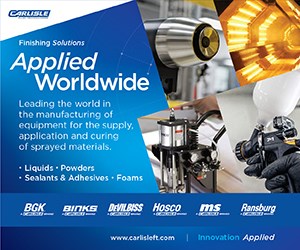Using Air Chop to Reduce Costs and Improve the Liquid Color-Change Process
My company has recently added several additional colors to our production mix. How do we reduce costs and improving the color-change process? Nordson’s Robin Schwamberger offers some advice.
Q. My company has recently added several additional colors to our production mix. These additional colors have created unexpected costs with solvent consumption and loss of production due to our more frequent change-overs. How do I reduce costs and improving the color-change process?
A. Customers are demanding a wider variety of colors and coatings for their products. This trend is creating issues in the manufacturing process for many liquid painting lines. Color changes are time-consuming and create additional costs for the manufacturer.
The color-change process requires the existing color to be flushed from the paint line and spray applicator before the new color is introduced for production. In most applications, this entails opening a valve and flowing some type of cleaning solvent through the paint line and out of the end of the spray gun. This requires a considerable amount of solvent. Frequently, the amount of solvent required to change colors is two to three times the volume of paint in the fluid lines. This is especially common when changing from a light color (like white) to a dark color (red or blue) or if spraying a catalyzed material. Friction along the inner diameter of the fluid line causes that portion of the hose to remain coated with the previous color.
There is a simple solution to overcome this phenomena: Introduce compressed air into the paint line during the color-change process. This is often called “air chop.” A separate line with compressed air can be added to the existing paint supply system. Note that it is good practice to add a check valve between the compressed air supply and the fluid passage. This prevents fluid pressure from causing paint to flow into the compressed air supply.
The addition of compressed air to the color change process offers several advantages:
- Less solvent is required to clean the paint line.
- Faster color changes can be achieved.
- It improves the life of the fluid line.
The compressed air supply also can be regulated to optimize the cleaning process. Compressed air is less expensive than cleaning solvent, and it also provides a vigorous scrubbing action within the fluid line. The ratio of compressed air to solvent can be adjusted as well to further enhance the cleaning process. This will require some experimentation to achieve best results. Simple timers or a programmable logic controller can be incorporated in the process to insure consistent results.
Recently, I talked to a plant manager of an automotive component supplier. He was having issues with residual two-component paint clogging his paint lines and static mixer. The existing dual-component system flushed the paint lines with solvent only. He was replacing fluid lines and mixing blocks twice per month. He installed a new dual-component metering system with an adjustable, integrated air-chop flush system. This system virtually eliminated unplanned downtime. Additionally, he now replaces the fluid lines ever three months instead of every two weeks. He is now a firm believer in air chop for productivity increases and maintenance reductions.
Air chop can be added to automated painting systems or manual spray operations. This simple retrofit can reduce your flush solvent usage by 50 percent or more. Investigate this simple enhancement to improve your production process.
Related Content
Pretreatment for Painting
Better adhesion, enhanced corrosion and blister resistance, and reduced coating-part interactions make pretreatment a must.
Read MoreZinc Phosphate: Questions and Answers
Our experts share specific questions about zinc phosphate and pretreatment
Read MoreMasking Solutions Provider CFS Dramatically Expands Capabilities and Capacity
Custom Fabrication & Supplies (CFS) completed a new plant expansion packing 10 times the capacity into twice the space. It dramatically enhances the supplier’s custom capabilities to provide extremely precise and cost-effective masking solutions.
Read MoreHenry Ford Is Still Right When It Comes to Color
Who would have imagined that more than 100 years after his famous statement about any color as long as it’s black would still have relevance of a sort?
Read MoreRead Next
The 2024 Ford Mustang: All the Colors Available
Although Chevrolet has announced the end of the Camaro and Dodge is offering “Last Call” editions of the Charger and Challenger, the Ford Mustang is launching to its seventh generation.
Read MoreEpisode 42: An Interview with Robin Deal, Hubbard-Hall
Hubbard-Hall wastewater treatment specialist Robin Deal discusses the latest trends in wastewater management.
Read MorePowder Coating 4.0: Smarter, Faster, More Efficient and Connected
New tools reduce cost and waste, lower manufacturing footprint of powder coating operations.
Read More

























